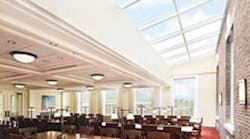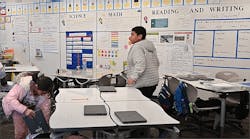Studies show that well-designed interiors can influence education profoundly. Awareness of the importance of sustainability and its role within the learning environment is growing. Research indicates a possible link between sustainable facilities and better learning outcomes.
Data from the U.S. Environmental Protection Agency indicates that improvements in air quality, lighting and other features can increase productivity markedly. A related study by the American Society of Heating, Refrigerating and Air-Conditioning Engineers (ASHRAE) suggests that a sustainable facility can improve a student's performance by 10 to 20 percent.
It comes as no surprise that education is one of the fastest growing markets for green buildings and LEED certification. The U.S. Green Building Council created the LEED (Leadership in Energy and Environmental Design) Green Building Rating System to encourage design and construction of high-performance, sustainable facilities. The shift toward architectural and site sustainability now is driving the need for a corresponding shift in furniture selection.
With about 10 percent of a building project's budget devoted to furniture, fixtures and equipment (FF&E), the impact of green design is rippling through the interiors industry.
The life cycle of furniture
Sustainability generally is defined as taking as little as possible from non-renewable resources. This definition sets up a framework for how to evaluate and choose furniture for a LEED project. First, look at the life-cycle stages of each product being considered. The decisions made by furniture manufacturers during the five life-cycle stages of a product's development have a direct effect on whether that product will contribute to LEED certification:
-
Material selection
The first question is "What's it made of?" What are the specific chemicals in this product? Are they safe for people and the planet? Is the material a rapidly renewable resource? By asking these questions, the manufacturer is held accountable for decisions made during the first step of a product's development.
Manufacturers submit their products for testing to organizations such as the American National Standards Institute (ANSI), the Business and Institutional Furniture Manufacturer's Association (BIFMA) Furniture Emissions Standards, and McDonough Braungart Design Chemistry (MBDC) Cradle-to-Cradle Certification, to name a few. Cradle-to-Cradle Certification is becoming the most sought-after certification because of its comprehensive testing. MBDC, a leader in the materials chemistry field, is an independent certifier that evaluates a product's chemical makeup against 19 human and environmental health criteria. It is important to look for products with low volatile organic compounds (VOCs) for cleaner indoor air and the elimination of carcinogens. These material selections will help determine points awarded in the LEED category "Indoor Environmental Quality — Low Emitting Materials."
-
Production
Look at how a product is made. What are the manufacturer's practices for operating a sustainable plant? Does it generate pollutants? Are its waste materials recyclable? Are recycled or regional materials used to produce the item? Answers to these questions may contribute points in the categories "Material & Resources — Recycled Content & Regional Materials" and "Innovation in Design."
-
Transportation
Getting furniture from the manufacturing plant to a building is the next consideration. How many miles will it travel, and how will it be packaged? The LEED rating system awards points for using products produced within 500 miles of a project. And because the furniture packaging affects the amount of trash created during installation, reusable blanket wraps or recyclable crates and boxes are preferred. Using local products in sustainable packaging can result in LEED points in the categories "Materials & Resources — Regional Materials and Construction Waste Management."
-
Use
How will the furniture be used? Selecting a product that is functional and durable is paramount. And depending on the use, flexibility may be a key consideration, too. Schools want to make sure that furniture will perform for many years and still look good. For a chair, ask "Is it easy to re-upholster?" For systems furniture, select a product line that is easy to reconfigure and offers the ability to purchase components on an ongoing basis. The use of existing and refurbished furniture meets LEED requirements for "Materials & Resources — Resource Reuse, 30 percent Furniture & Furnishings."
-
End-of-Use
Recyclability is an important consideration when selecting sustainable furniture. "Cradle-to-cradle" describes a product that can be disassembled at the end of its life so that the parts can be recycled into new products — its materials are circulated perpetually in closed loops. More furniture is being designed with this concept in mind, so ask the manufacturer "What end-of-life strategies have you developed for your products?" and "How quickly or easily can the product be disassembled?" If disassembly is long and involved and requires multiple tools, it is unlikely that a user actually will recycle the product. Many companies offer buy-back programs that help customers recycle products. Products also are being designed with labeled component parts to facilitate recycling. These leading-edge concepts fall under the LEED category "Innovation in Design," and offer the highest potential for points earned within one category.
Breaking it down
The furniture evaluation process may seem complicated and confusing, but there is good news. Many furniture manufacturers recognize that their sales depend on easy availability of this valuable information. Websites now provide product environmental data sheets listing LEED criteria for each chair, desk or table for sale, helping education institutions make informed, sustainable choices.
The green movement in education is not just a trend. The expectations of leaders, students and the public have changed. A cultural shift has taken place, and those who don't get on board will be left behind.
Even with the economic downturn, it is possible to have a financially realistic and defensible approach to sustainability. By extending sustainable design into the interior spaces via green furniture choices, education institutions can help deliver more healthful and more environmentally sound buildings.
Pye, IIDA, ASID, is the founder and managing director of Pye Interiors, Charlottesville, Va. She can be reached at [email protected] or (434)971-1393.
Notable
10
Percentage of a building's project budget devoted to furniture, fixtures and equipment (FF&E).


